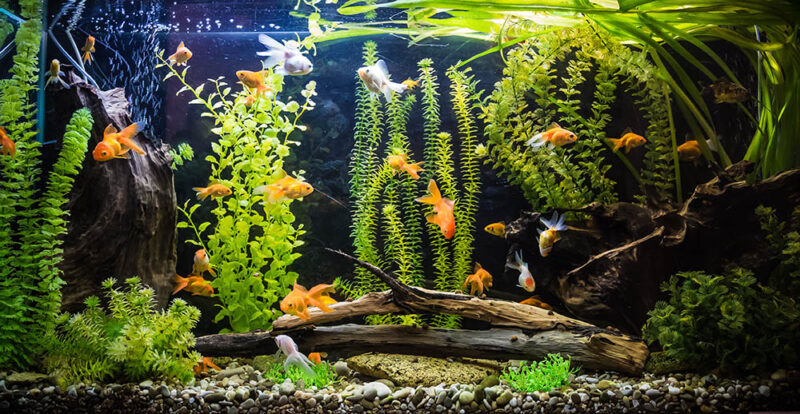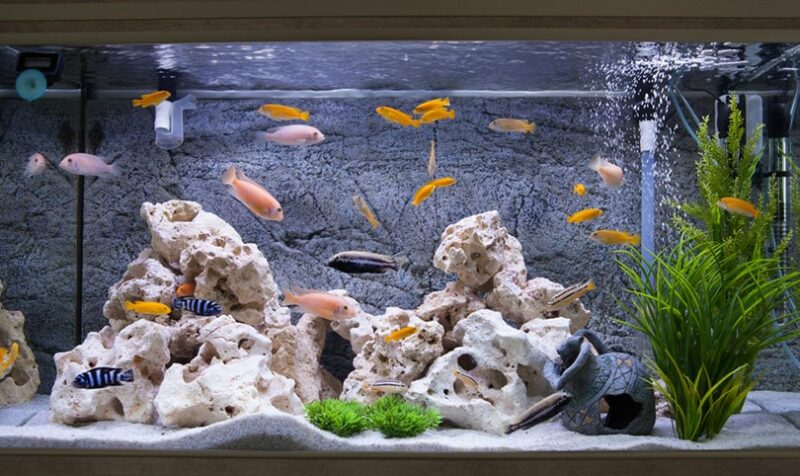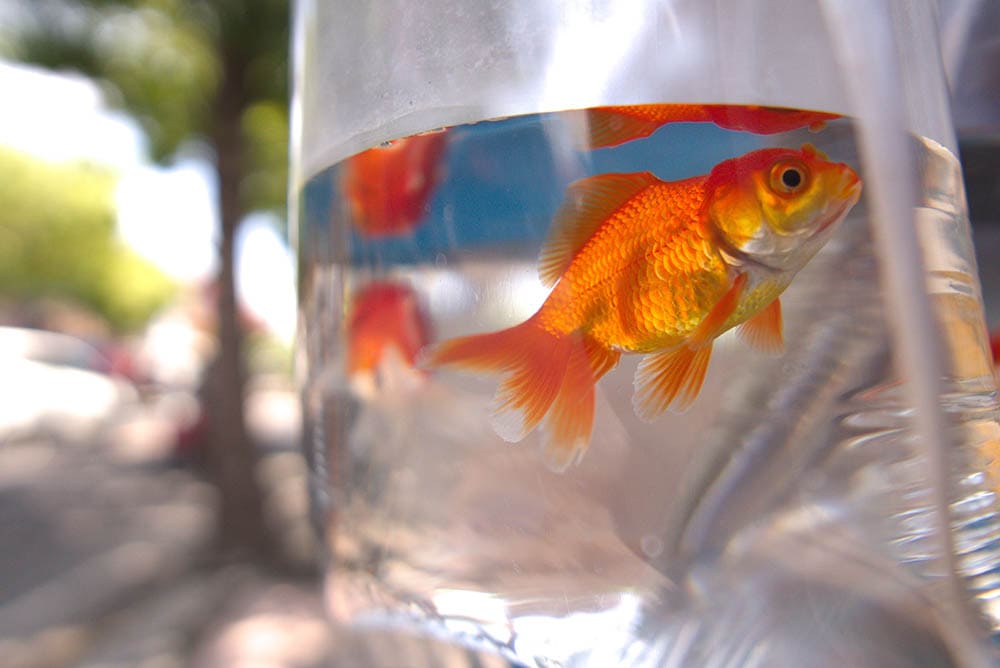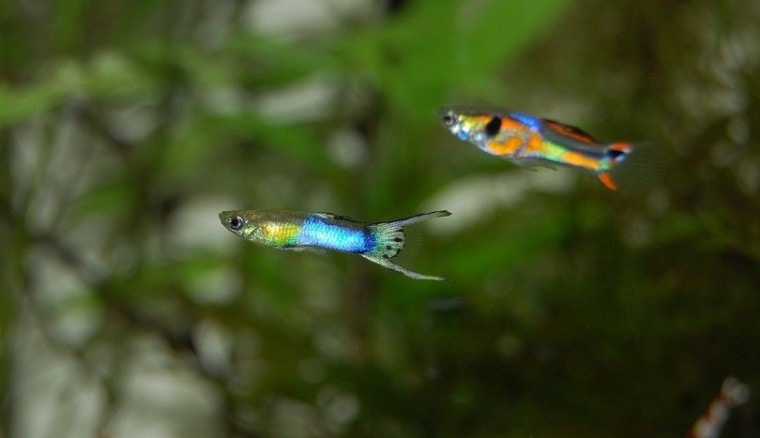
Small fish that are generally no longer than two inches with females that outsize the males, guppies are wildly popular pets that can live up to five years in captivity, though most only survive two or three. You may not realize that guppies are named after the man who discovered the species: Robert John Lechmere Guppy.
What’s incredible about this species aside from their adaptability and widespread existence throughout the world is their incredible diversity of appearance. There are many different types of guppies available, classified by color, pattern, species, and even by their tails. Let’s take a closer look at some of these exotic, yet tiny fish.
The 60 Types of Guppy Patterns, Colors & Tails
While guppies come in practically endless combinations of colors and patterns, all of those wild variations are grouped in just three main species of guppy.
1. Endler
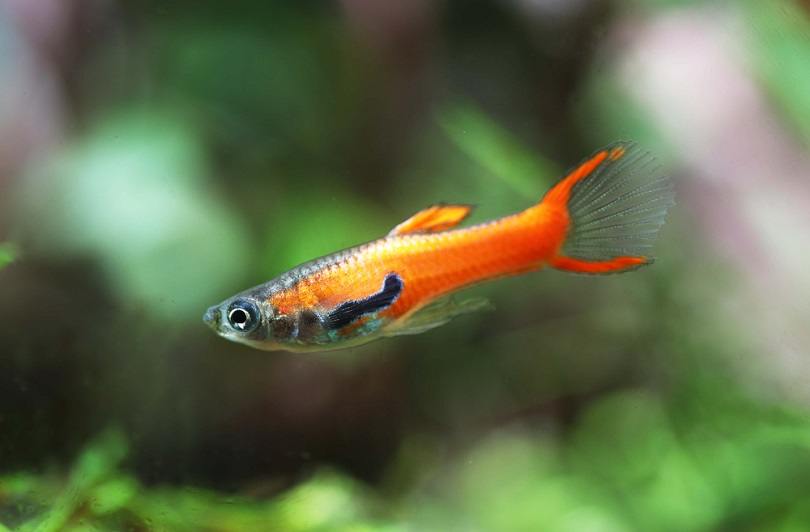
Endler guppies display vivid colorations of silver, black, and orange, with metallic shades that make them shine in the light. Though incredibly beautiful, you’ll rarely see these fish in stores. The scientific name for Endler guppies is Poecilia wingei.
2. Fancy
Fancy guppies, also known as common guppies, are the type of guppy you’ll most often find in fish stores and aquariums. They top out at about 1.5 inches in length with females usually outsizing the males. The scientific name for a fancy guppy is Poecilia reticulata.
3. Scarlet Livebearer

Also known as swamp guppies, the Scarlet Livebearer’s scientific name is Micropoecilia picta. These little guppies live in brackish water and are rare in aquariums.
 Solid Colors
Solid Colors
These guppies feature a single color that covers them from head to tailfin. You can find solid guppies in several colors, including colors that don’t appear in nature.
4. Black
You won’t find a black guppy in the wild because these fish were created through captive breeding. Solid black guppies are a sight to behold and they’re pretty rare, causing them to be some of the more expensive guppies on the market.
5. Blue
Most blue guppies aren’t just blue; they’re an electric blue that seems to glow in the light. Females might even have blue highlights in their fins as well.
6. Green
Solid green guppies are very rare and they’re a pretty recent addition to the guppy family. They were created through captive breeding and most of them aren’t entirely green, often having some blue strewn in.
7. Purple
Purple guppies feature a luscious violet color on their entire body and fins. They can also exhibit some black, particularly around the edges of their fins.
8. Red
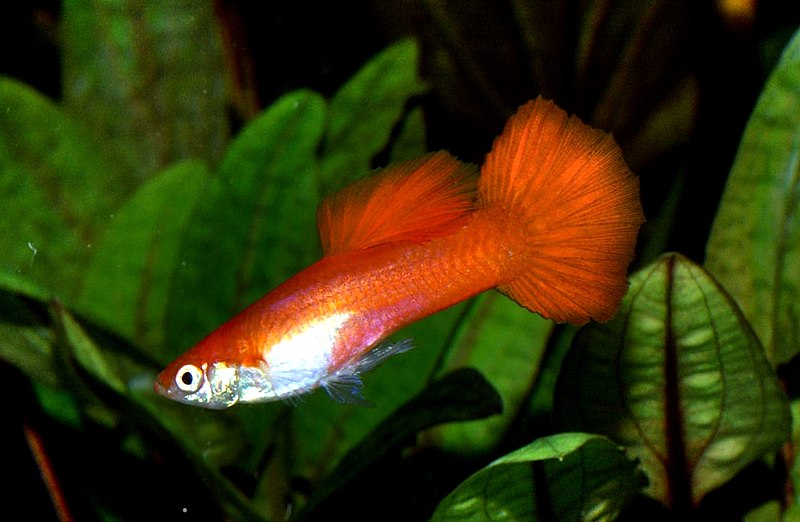
These guppies are a deep blood-red color all over that gives them a striking appearance that stands out; even among the wild colors and patterns common to guppies.
9. Yellow
Yellow guppies aren’t quite as brightly colored as some of the other solid-colored guppies. These guppies are actually blond genetically, created by careful breeding intended to reduce the black color gene. These are hard to find and expensive, so expect to spend some time searching if you want to add one to your aquarium.
Bi-Color
These bi-color guppies are half black and half another color. They’re truly half and half too. Half the body is black while the other half is another color, creating some interesting and truly eye-catching fish.
10. Blue-Green
Blue-green guppies are predominantly blue or green with much of the second shade present. The dorsal and tail fin must match in pattern and color. Sometimes they even include a third color. But if the third color makes up more than 15% of the fish, then they’ll be considered a multi instead.
11. Half-Black & Blue

These guppies are eye-catching with a body that’s half black and half blue. The blue half can range in hue from a deep shade to a bright electric blue that almost seems to glow in the dark.
12. Half-Black & Green
Green guppies are already quite rare, so, finding a half-black and green guppy takes some serious searching and patience, not to mention a hefty sum to purchase. Half of this fish’s body is black with the other half green. They can also have small areas of gold coloration around the face.
13. Half-Black & Pastel

This fish presents some variety. Like other half-black guppies, this fish will have a body that’s half black. The other half is pastel, but it can be any color other than yellow.
14. Half-Black & Purple
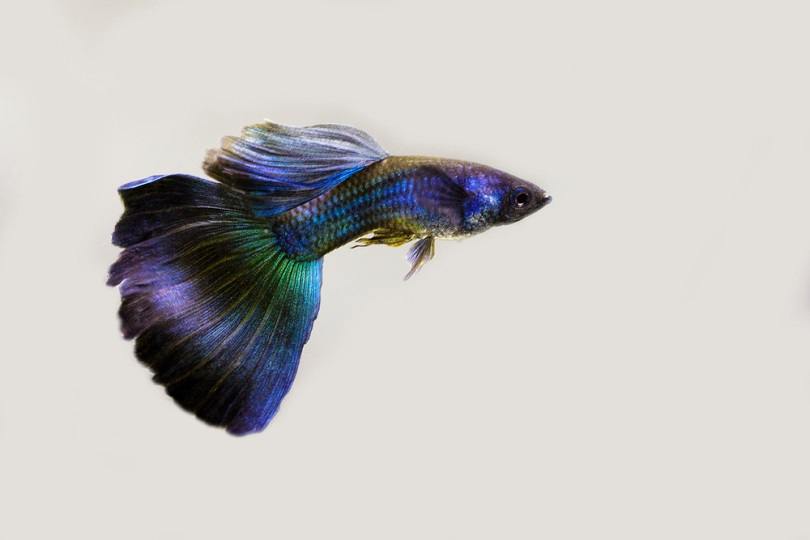
Good luck finding one of these rare and beautiful guppies! They have bodies that are black with a fin and tail that are deep purple, creating a rich, royal look.
15. Half-Black & Red

Red and black always look striking next to each other, so you can imagine that the half-black and red guppy is quite a standout fish with a body that’s half black and half a deep blood-red.
16. Half-Black & Yellow
It’s not an underwater bee, though the coloration is spot-on. These fish have bodies that are half black and half yellow; a pattern with a lot of contrast that immediately catches your eye.
Patterns
Patterns are common in guppies. They can range from two-tone patterns to complex patterns made up of multiple colors, stripes, spots, and more.
17. Black Cobra
Black cobra guppies feature the cobra pattern in a black variation, with a pattern of spots and stripes.
18. Blue Cobra
Similar to black cobras, blue cobra guppies are guppies with a cobra pattern in blue.
19. Cobra

The cobra pattern is made up of spots and stripes. The fish’s body, fin, and tail will be covered in a spotted pattern, while the front of the body is adorned in vertical stripes.
20. Green Cobra

A guppy with a cobra pattern in a bright green color.
21. Jarawee Lazuli
You may have never heard of this interesting guppy, but you’ve likely heard of its namesake: the lapis lazuli gemstone. This stone is a bright aquamarine color; the same color as the head of the Jarawee Lazuli guppy. Only the head of this guppy is blue though, which is what makes it so unique.
22. Panda
Panda guppies have a pattern that loosely resembles the coloration of a panda bear with dark black covering half the body, the dorsal fins, and the tail, as well as ringing the eyes. The remainder of the body is a much lighter color, which gives them the panda two-tone appearance.
23. Red Cobra
Like other cobra variations, the red cobra guppy is a guppy with a red cobra pattern of stripes and spots.
24. Snakeskin
Snakeskin guppies have a pattern that’s similar to a snake, going down their bodies and tailfins. The pattern can also appear closer to a tiger’s pattern in some specimens.
25. Tuxedo
Tuxedo guppies have two-toned bodies. The rear half is usually darker than the front, and they’re separated by something of a design, rather than a straight line as is common with half-black varieties.
Tails & Tail Patterns
Guppies can be classified by the shape of their tail, as well as by the pattern their tailfins display.
26. Bottom Swordtail
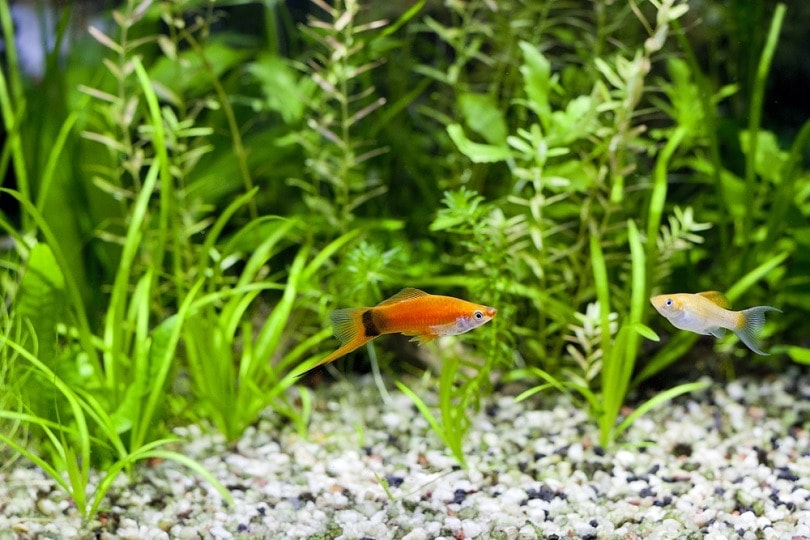
Bottom swordtail guppies are swordtail guppies where only the bottom of their tail is elongated and the top is short, creating a sharp sword-like appendage from the bottom of the tailfin.
27. Coffer Tail
Also known as spade tail guppies, these are very small fish with tails that are almost exactly half the length of the body.
28. Delta Tail
It’s common to hear these guppies also called triangular tail guppies. Their tails are large and triangular shaped, spanning a full 70 degrees Fahrenheit.
29. Double Swordtail
These guppies have a tailfin that has long sword-like extensions off the top and bottom, creating a double-sword appearance.
30. Dragon Head
With such a name, this guppy better be quite the looker! Luckily, it is, with a dorsal fin and tail that display flaming red-orange hues and a two-tone body that’s dark in the rear and lighter in the front.
31. Fantail
Fantail guppies have massive tails that fan out to a width that’s equal to 75% of the fish’s total body length. They also have long, flowing dorsal fins that don’t end until one-third of the way down the tailfin.
32. Fire Tail
You can instantly tell a fire tail guppy by the red-orange coloration that marks the end of its tailfin. When flowing in the water, this bright tailfin has the appearance of underwater fire, giving this fish its name.
33. Flag Tail
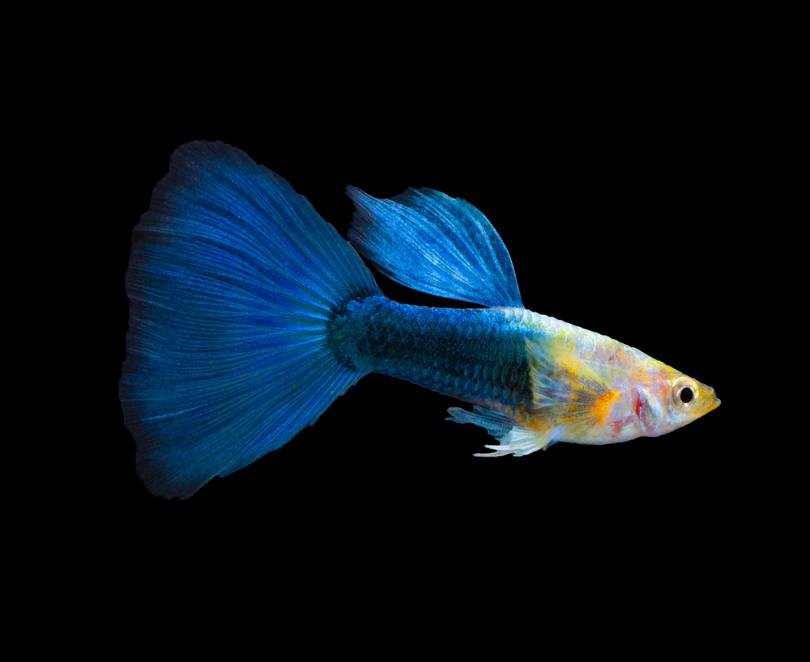
Though these guppies have small tails that are rectangular in shape, their tails really sway, causing it to look like a small flag flying in the wind.
34. Glass

Glass guppies have clear tails that you can see right through. Moreover, they have none of the silver coloration that’s common to many guppies, though they often sport other bright metallic colors.
35. Grass Tail

Small guppies with a similar appearance to leopard tail guppies, these fish feature small dots on their tails that look like grass seeds, allowing you to tell them apart.
36. Halfmoon Tail
If you’re looking for the fanciest guppy, you might find it in the half-moon tail. These guppies have large tails that come in a wide range of colors and patterns; all of which look amazing when they’re waving and flowing in the water.
37. Lace Tail

These guppies feature intricate patterns on their long, flowing tails that give them the appearance of delicate lace. They often have incredible coloration like blue, red, or orange that really brings their unique patterning to life.
38. Leopard Tail
Some leopard tail guppies feature orange and black patterns that make their tails resemble a leopard’s markings. Others feature the same pattern in some truly unique color schemes, including reds, whites, blues, and blacks.
39. Lyretail
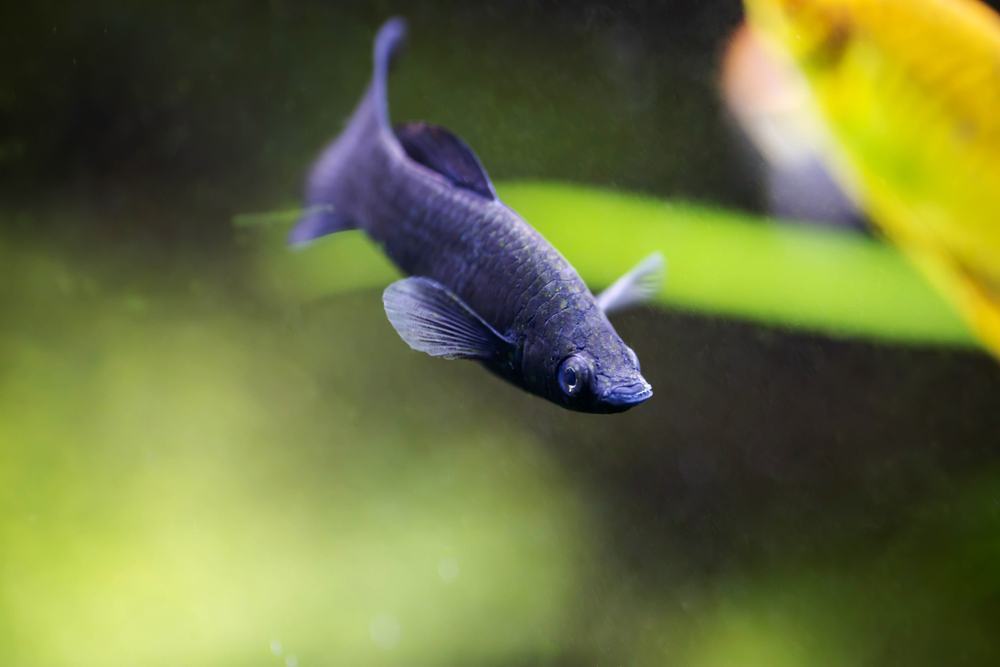
Lyretails are popular with aquarists because they’re quicker to mature than most guppies. They have double tail fins of yellow and white with bodies that are silver, green, and red.
40. Mosaic Tail
These guppies have incredibly fancy tails featuring iridescent and metallic coloring.
41. Pin/Needle Tail
Pin tail guppies have dorsal and tail fins that are made up of long, needle-like strips.
42. Round Tail
These fish don’t have very large tails, but the shape is distinctly round, like a ball-shaped fin at the back of the fish.
43. Spear Tail
Spear tail guppies tend to be much larger than other guppies, with a tail that’s shaped like the tip of a spear.
44. Swordtail
Swordtail guppies have long, narrow tails that come to a point and resemble a sword. But their bodies are similarly long and narrow, giving them an appearance similar to a miniature swordfish.
45. Top Swordtail
You can easily pick out a top swordtail guppy by the single extension at the top of their tail that protrudes like a sword tip.
46. Veil Tail
The tails on these fish are isosceles triangles where each angle is a clean 45 degrees, creating an impressive look that’s geometrical and eye-catching.
Other
47. Albino
Like most albino creatures, these guppies feature white bodies that are practically see-through. They have red eyes and large tails that can display vibrant colors such as blue and pink.
48. AOC
AOC stands for any other color. These guppies can be any color that’s not a specified existing guppy class. This includes colors like yellow and pink, which can make for a very attractive and unique fish.
49. AOC Bi-Color
These fish feature a bi-color pattern using any other colors that aren’t the standard half-black.
50. Bronze
Genetically, bronze guppies are actually gold with black outlines. They often have tails that are bicolor with either red or green and black. To meet show standards for guppies, a bronze guppy must display at least 25% gold coloring.
51. Dumbo Ear
The large pectoral fins that these little guppies sport make it look like they have giant dumbo ears, earning them their name. They can come in a variety of colors and patterns.
52. Female

Female guppies are generally larger than males, though they’re also much less colorful. They’re often just silver with coloration on just the fins. Breeders are working to select the most colorful females for continued breeding, but they’re still not as vibrant and diverse as males.
53. Koi
These guppies are so-named because they resemble koi fish. They have tails and faces that are red with a white body. Sometimes, even females can display this coloring and pattern.
- Related Read: Do Koi Eat Other Fish?
54. Metal
These are some of the most unique guppies of all due to their special pigment. Metal guppies have iridophores, which allow them to change their color, mimicking their environment, and making it easier to hide from danger.
55. Mutt
As you might guess, mutt guppies come in a wide range of different patterns and colors. They have loads of genetic diversity from random interbreeding among species and colors, but this makes their lines unstable and difficult to duplicate, so they’re less desirable than fancy guppies that are created through selective breeding.
56. Moscow
These guppies come in several variations with tails that are long, flowing, and fancy. They can be solid black, purple, or green.
57. Multi
Multi-colored guppies are fish displaying three or more colors. Each of the three colors must make up at least 15% of the fish’s total coloration.
58. Real Red Eye
Smaller than your average guppy and far rarer as well, these guppies are named for their bright red eyes that make them stand out among guppies.
59. Real Red Eye Albino

An albino variant of the Real Red Eye guppy that has eyes that are more of a pink than a red due to the lack of melanin in their eyes.
60. White
At first appearance, white guppies are quite similar to albinos. But these are actually pastel fish with white coloration and no secondary colors. Even the eyes are white, unlike albino guppies that often have pink or red eyes instead.
Conclusion
Guppies are one of the most versatile species of fish you could add to your aquarium. They come in such a wide range of colors and patterns that you could never have them all! These colors are as diverse as people are, guaranteeing that you can find a fancy guppy that tickles your fancy.
Want to know what other kinds of fish would be great in your aquarium? Check out these great posts:
- 13 Types of Clownfish Species for your Aquarium (With Pictures)
- 40 Types of Cichlids for your Aquarium (With Pictures)
- 18 Popular Types of Gourami Fish (with Pictures)
Featured image credit: basuka, Pixabay

 Solid Colors
Solid Colors